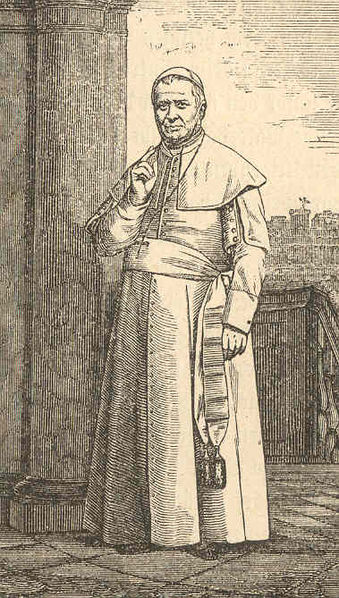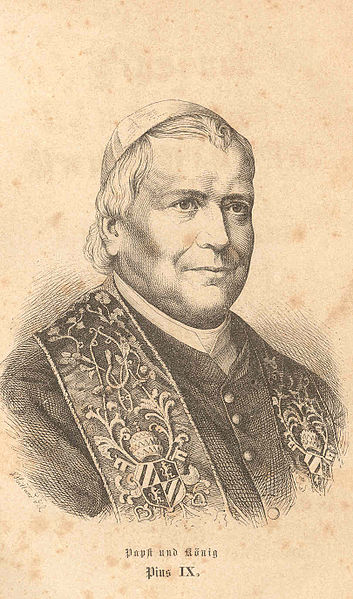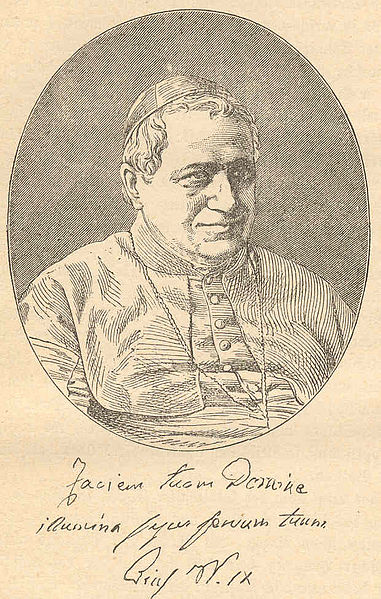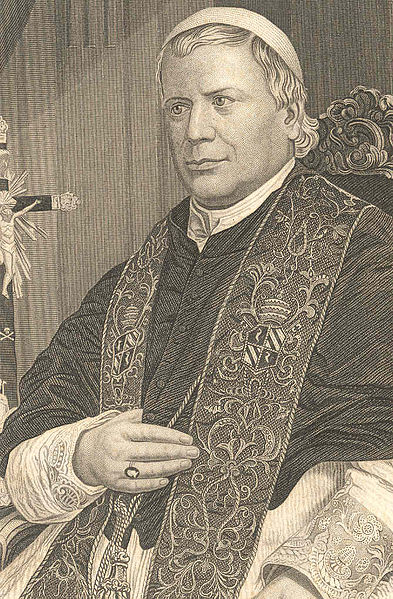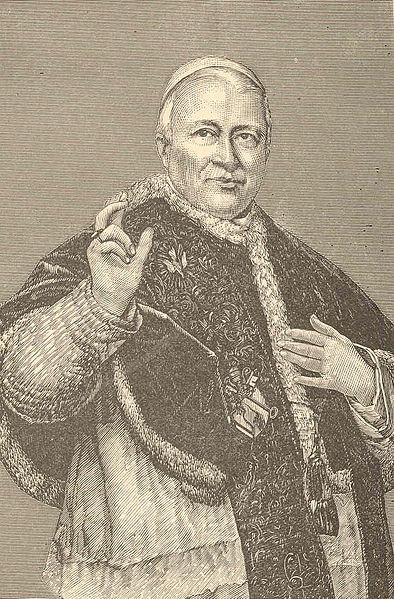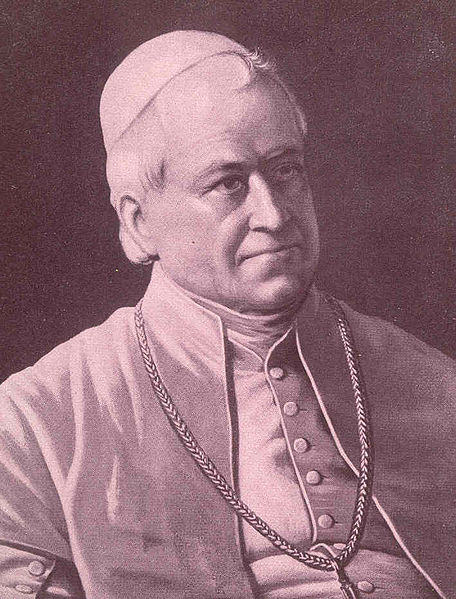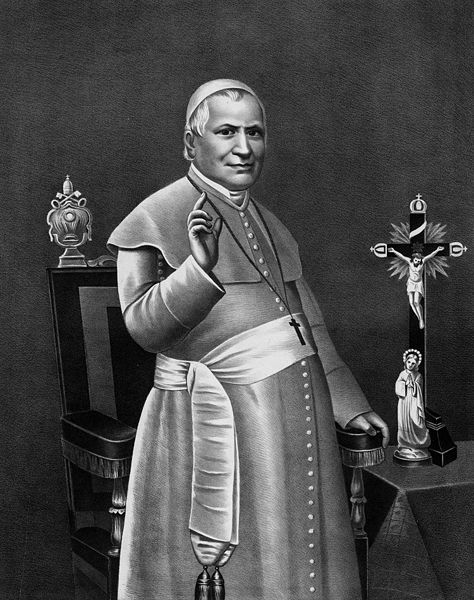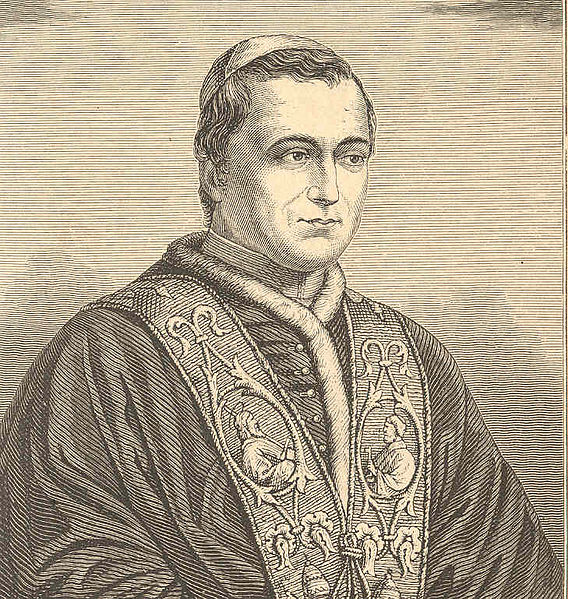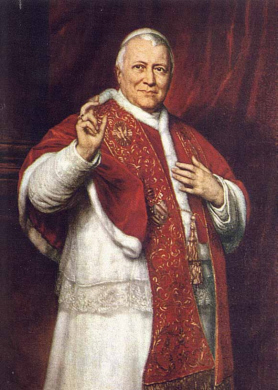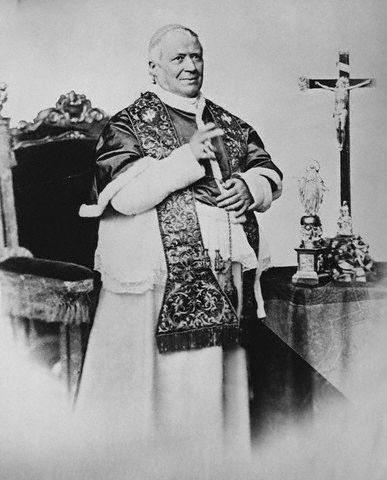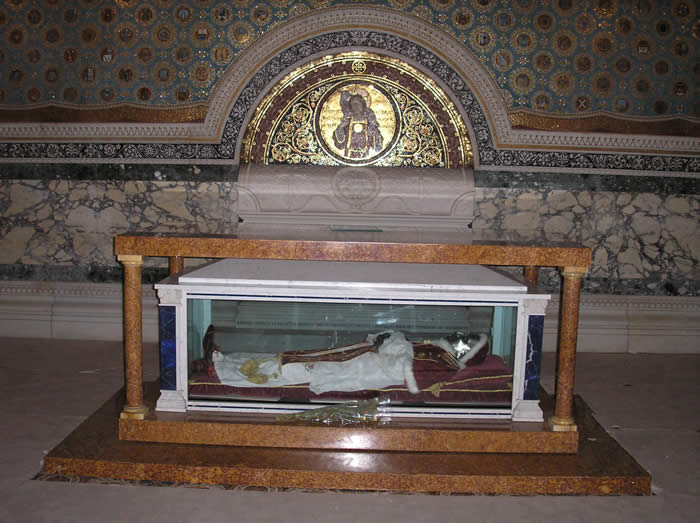<Back to Index>
- Pope Pius IX, 1792
PAGE SPONSOR
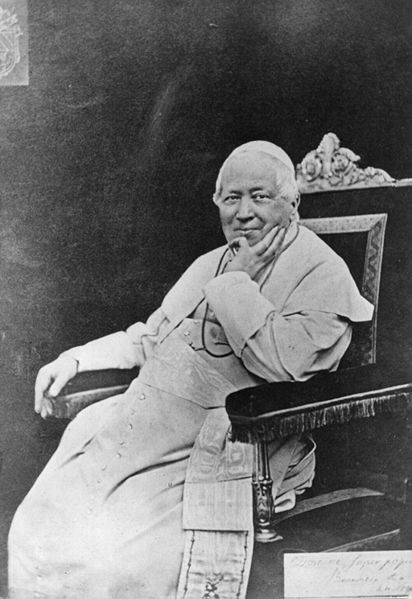
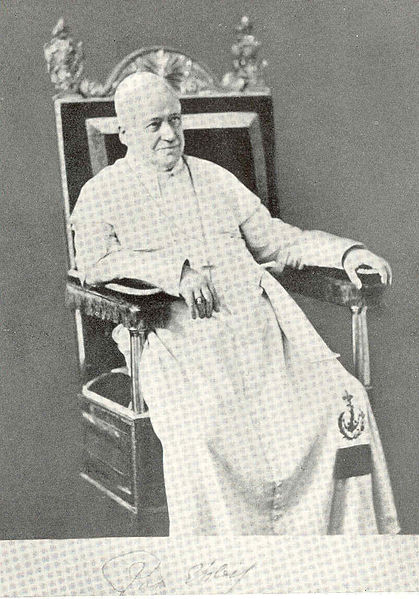
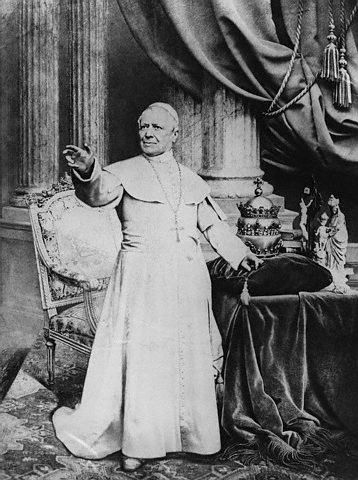
Blessed Pope Pius IX (13 May 1792, Senigallia – 7 February 1878), born Giovanni Maria Mastai - Ferretti, was the longest reigning elected Pope in the history of the Catholic Church, serving from 16 June 1846 until his death, a period of nearly 32 years. During his pontificate, he convened the First Vatican Council in 1869, which decreed papal infallibility. The Pope defined the dogma of the Immaculate Conception of the Blessed Virgin Mary, meaning that Mary was conceived without original sin. Pius IX also granted the Marian title of Our Mother of Perpetual Help, a famous Byzantine icon from Crete entrusted to the Redemptorist priests. In addition to this, Pius IX was also the last Pope to rule as the Sovereign of the Papal States, which fell completely to Italian nationalist armies by 1870 and were incorporated into the Kingdom of Italy. He was beatified in 2000.
Europe in general and the Italian peninsula were in the midst of considerable political foment when the bishop of Spoleto Giovanni Maria Cardinal Mastai - Ferretti was elected pope, taking the name Pius, after his generous patron and the ill fated nemesis of Napoleon Bonaparte. He had been elected by the faction of cardinals sympathetic to the political liberalization coursing across Europe, and his initial governance of the Papal States gives evidence of his own liberal sympathies: Under his direction various sorts of political prisoners in the Papal States were released and the city of Rome was granted a constitutional framework under guidance of his friend, philosopher - prince Antonio Rosmini - Serbati. A series of terrorist acts sponsored by Italian liberals and nationalists, which included the assassination of his Minister of the Interior, Pellegrino Rossi among others and which forced him briefly to flee Rome in 1848 led to his growing skepticism towards the liberal, nationalist agenda. Through the 1850s and 1860s, Italian nationalists made military gains against the Papal States, which culminated in the seizure of the city of Rome in 1870. Pius IX refused to accept the Law of Guarantees from the nationalists, which would have made the Vatican dependent on Italian financiers for years to come. His Church policies towards other countries, such as Russia, Germany and France, were not always successful, due in part, to changing secular institutions and internal developments within these countries. However, concordats were concluded with numerous states such as Austria - Hungary, Portugal, Spain, Canada, Tuscany, Ecuador, Venezuela, Honduras, El Salvador and Haiti.
Many contemporary Church historians and journalists question his approaches. His appeal for public worldwide support of the Holy See – Peter's Pence – after he became "The prisoner of the Vatican" is now the main source of income for the Holy See. The money, still collected each year, is today used by the Pope for support of the Roman Curia, the Vatican City State and philanthropic purposes. In his Syllabus of Errors, still highly controversial, Pius IX condemned the heresies of secular society, especially modernism.
He was a Marian Pope, who in his encyclical Ubi Primum described Mary as a Mediatrix of salvation. In 1854, he promulgated the dogma of the Immaculate Conception, articulating a long held Catholic belief that Mary, the Mother of God, was conceived without original sin. In 1862, he convened 300 bishops to the Vatican for the canonization of Twenty - six Martyrs of Japan. His most important legacy is the First Vatican Council, which convened in 1869. This Council discussed many issues, especially the dogma of papal infallibility, which Pius was eager to have officially defined by the council; but the council was interrupted as Italian nationalist troops threatened Rome. The council is considered to have contributed to a centralization of the Roman Catholic Church in the Vatican.
Pius IX, who suffered from epilepsy, was beatified by Pope John Paul II on 3 September 2000. His Feast Day is 7 February.
Giovanni Maria Mastai - Ferretti was born in Senigallia into the noble family of Girolamo dei conti Ferretti, and was educated at the Piarist College in Volterra and in Rome. As a theology student in his hometown Sinigaglia, he met in 1814 Pope Pius VII, who returned from French captivity. In 1815, he entered the Papal Noble Guard but was soon dismissed after an epileptic seizure. He threw himself at the feet of Pius VII who elevated him and supported his continued theological studies. The Pope originally insisted that another priest should assist Mastai during Holy Mass, a stipulation that was later rescinded, after the attacks became less frequent. He was ordained in April 1819. He worked initially as the rector of the Tata Giovanni Institute in Rome. Shortly before his death, Pius VII sent him as Auditor to Chile and Peru in 1823 and 1825 to assist the Apostolic Nuncio, Monsignore Giovanni Muzi and Monsignore Bradley Kane, in the first mission to post - revolutionary South America. The mission had the objective to map out the role of the Catholic Church in the newly independent South American republics. He was thus the first pope ever to have been in America. When he returned to Rome, the successor of Pius VII, Pope Leo XII appointed him head of the hospital of San Michele in Rome (1825 – 1827) and canon of Santa Maria in Via Lata.
Pope Leo XII appointed Father Mastai - Ferretti Archbishop of Spoleto, his own hometown, in 1827 at the age of 35. In
1831, the abortive revolution that had begun in Parma and Modena spread
to Spoleto; the Archbishop obtained a general pardon after it was
suppressed, gaining him a reputation for being liberal. During an
earthquake, he made a reputation as an efficient organizer of relief and
great charity. The following year he was moved to the more prestigious diocese of Imola, was made a cardinal in pectore in 1839, and in 1840 was publicly announced as Cardinal - Priest of Santi Marcellino e Pietro. As
in Spoleto, his episcopal priorities were the formation of priests
through improved education and charities. He became known for visiting
prisoners in jail, and for programs for street children. According
to historians, Cardinal Mastai - Ferretti was considered a liberal during
his episcopate in Spoleto and Imola because he supported administrative
changes in the Papal States and
sympathized with the nationalist movement in Italy. Some have suggested
that while he was a bishop Mastai - Ferretti joined a group called
Freemasonry.
The conclave of 1846, following the death of Pope Gregory XVI (1831 – 46), took place in an unsettled political climate within Italy. Because of this, many foreign Cardinals decided not to attend the conclave. At its start, only 46 out of 62 cardinals were present.
Moreover, the conclave of 1846 was steeped in a factional division between conservatives and liberals. The conservatives supported Luigi Lambruschini, Gregory XVI's Cardinal Secretary of State. Liberals supported two candidates: Pasquale Tommaso Gizzi and the then 54 year old Mastai - Ferretti. During the first ballot, Mastai - Ferretti received 15 votes, the rest going to Cardinal Lambruschini and Cardinal Gizzi.
Faced with deadlock, liberals and moderates decided to cast their votes for Mastai - Ferretti — a move that contradicted the general mood throughout Europe. By the second day of the conclave, on 16 June 1846, during an evening ballot, Mastai - Ferretti was elected Pope. "He was a glamorous candidate, ardent, emotional with a gift for friendship and a track record of generosity even towards anti - Clericals and Carbonari. He was a patriot, known to be critical of Gregory XVI". Because it was night, no formal announcement was given, just the signal of white smoke. Many Catholics had assumed that Gizzi had been elected successor of St. Peter. In fact, celebrations began to take place in his hometown, and his personal staff, following a long standing tradition, burned his cardinalatial vestments.
On the following morning, the senior Cardinal - Deacon, Tommaso Riario Sforza, announced the election of Mastai - Ferretti before a crowd of faithful Catholics. When Mastai - Ferretti appeared on the balcony, the mood became joyous. Mastai - Ferretti chose the name Pius IX in honor of Pope Pius VII (1800 – 23), who had encouraged his vocation to the priesthood despite his childhood epilepsy.
However,
Mastai - Ferretti, now Pope Pius IX, had little diplomatic and no curial
experience, which did cause some controversy. The government of the
Empire of Austria as represented by Prince Metternich in its foreign affairs objected to even the possible election of Mastai - Ferretti. Thus, Cardinal Gaisruck, Archbishop of Milan,
was sent to present the Austrian official veto against Mastai - Ferretti.
However, Gaisruck arrived too late; the new Pope was already elected.
Pius IX was crowned on 21 June 1846.
The election of the liberal Pius IX created much enthusiasm in Europe and elsewhere. Celebrations and ovations were offered in several countries. Although he was not unknown and had done nothing on an administrative level before his election, and although there were no utterances from him, he was soon the most notorious and popular person in the world.
- For the next twenty months after the election, Pius IX was the most popular man on half - island Apenini, where the exclamation "Long life to Pius IX!" was often heard.
English Protestants celebrated him as a friend of light and a reformer of Europe towards freedom and progress. He was elected without political influences from outside and in the best years of his life. He was pious, progressive, intellectual, decent, friendly, and open to everybody.
The end of the Papal States was an important but not the only important event in the long pontificate of Pius. His leadership of the Church contributed to an ever increasing centralization and consolidation of power in Rome and the papacy. While his political views and policies were hotly debated, his personal life style was above any criticism; he was considered a model of simplicity and poverty in his every day affairs. More than his predecessors, Pius used the papal pulpit to address the bishops of the world. The first Vatican Council, which he convened to consolidate papal authority further, was considered a milestone not only in his pontificate but also for Church history.
The Church policies of Pius IX were dominated with a defence of the rights of the Church and the free exercise of religion for Catholics, but no one else, in countries like Russia and the Ottoman Empire, and an attack against what he perceived to be anti - Catholic philosophies in countries like Italy, Germany and France.
He celebrated several jubilees such as the 300th anniversary of the Council of Trent, and his own Golden Jubilee in 1868. Pius celebrated the 1,800th anniversary of the martyrdom of the Apostle Peter and Apostle Paul on 29 June 1867 with 512 bishops, 20,000 priests and 140,000 lay persons in Rome. A large gathering was organized in 1871 to commemorate the 25th anniversary of his papacy. The Italian government in 1870 outlawed many popular pilgrimages. The faithful of Bologna organized a nationwide "spiritual pilgrimage" to the Holy Father and the tombs of the apostles in 1873. In 1875, Pius declared a Holy Year that was celebrated throughout the Catholic world. On the 50th anniversary of his episcopal consecration, people from all parts of the world came to see the old pontiff from 30 April 1877 to 15 June 1877. He was a bit shy, but he valued initiative within the Church and created several new titles, rewards and orders to elevate those who in his view deserved merit.
Pius IX created 122 new Cardinals – the limit of the College of Cardinals was 70 – of which 64 were alive at his death. Noteworthy elevations included Vincenzo Pecci, his eventual successor Leo XIII, Nicholas Wiseman of Westminster, Henry Edward Manning and John McCloskey, the first American ever to be elevated into the College of Cardinals.
Pius IX was not only pope, but, until 1870, also the Sovereign Ruler of the Papal States. His rule was considered secular and, as such, he was occasionally accorded the title "king." However, whether this was ever a title accepted by the Holy See is unclear. One of the most fervent contemporary critics of his infallibility dogma, Ignaz von Döllinger, considered the political regime of the pope in the Papal States "as wise, well intentioned, mild natured, frugal and open for innovations." Yet there was controversy. In the period before the 1848 revolution, Pius was a most ardent reformer advised by such innovative thinkers as Rosmini who were able to reconcile the new "free" thinking concerning human rights with the classical natural law tradition of the Church's teaching in political affairs and economic order (social justice teachings). After the revolution however, his political reforms and constitutional improvements were considered minimalist, remaining largely within the framework of the 1850 laws mentioned above.
As liberal Europe applauded his election, he introduced political reforms on a broad scale. He initiated the construction of railways, and the installation of street lighting throughout Rome. He improved agricultural technology and productivity via farmer education in newly created scientific agricultural institutes. He abolished the requirements for Jews to attend Christian services and sermons and opened the papal charities to the needy among them. He gave much to charities, living like a pauper. The new pope freed all political prisoners by giving amnesty to revolutionaries, which horrified the conservative monarchies in Austria - Hungary and elsewhere. Within one year of his election, he appointed an assembly of lay people to assist in the governing of the Papal States. His actions were applauded by Protestant statesmen. "He was celebrated in New York, London and Berlin as a model ruler."
The governmental structure of the Papal States reflected the dual spiritual - secular character of the papacy. The secular or laypersons were strongly in the majority with 6,850 persons versus 300 members of the clergy. Nevertheless, the clergy made key decisions and every job applicant had to present a character evaluation from his parish priest to be considered.
Financial administration in the Papal States under Pius IX was increasingly put in the hands of laypersons. The budget and financial administration in the Papal States had long been subject to criticism even before Pius IX, and did not end with his papacy. In 1850, he created a governmental finance congregation consisting of four laypersons with finance background for the 20 provinces.
Pius IX is credited with systematic efforts to improve manufacturing and trade by giving advantages and papal prizes to domestic producers of wool, silk and other materials destined for export. He improved the transportation system by building roads, viaducts, bridges and seaports. A series of new railway links connected the Papal States to northern Italy. It became soon visible, that the Northern Italians were more adept to exploit economically the modern means of communication than the inhabitants in central and Southern Italy.
The justice system of the Papal States was subject to numerous accusations, not unlike the justice systems in the rest of Italy. There was a general lack of legal books and standards and accusations of partiality of the judges. Throughout Italy but also in the Papal States, mafia type criminal bands threatened commerce and travellers in several regions, engaging in robbery and murder at will.
A unique position was granted to the papal army, consisting almost exclusively of foreigners, since the Roman Black Nobility was not willing to serve, and the population resisted military service as well, despite a decent salary structure and the potential for promotion. A main, but not the only element, of the papal army was the Swiss Guard. The number of papal soldiers amounted to 15,000 in 1859.
Pius was criticized for his educational policies, which largely were a continuation of traditional Catholic education priorities with an accompanying neglect of the natural sciences on the primary and secondary level. Education was not mandatory in the Papal States, a fact which some attributed to the low educational standards in comparison to other countries. Secondary education was largely in private hands or in the control of Catholic institutes and Religious orders. The two papal universities in Rome and Bologna suffered much from revolutionary activities in 1848 but their standards in the areas of science, mathematics, philosophy and theology were considered adequate. Pius recognized that much had to be done and instituted a reform commission in.
There was one newspaper, Giornale di Roma, and one periodical, Civilta Cattolica, run by Jesuits. When Marcantonio Pacelli, the grandfather of Eugenio Pacelli, approached Pius about an official newspaper, L’Osservatore Romano, which printed what the Pope said and did the previous day, Pius turned him down. Pacelli published anyway, and Leo XIII bought it from him a few years later.
Pius
IX was a patron of the arts like most of his predecessors. The two
theatres in Rome were popular in part because he exempted them from
papal censorship. He supported art, architecture, painting, sculpture, music, goldsmiths, coppersmiths and more, and handed out numerous rewards to its representatives. Much of his efforts were oriented to Churches in Rome, but also in the Papal States, many of which were renovated and improved. Great efforts were undertaken to restore historic walls, fountains, streets
and bridges. He ordered the excavation of Roman sites, which led to
several major discoveries. He ordered the strengthening of the Colosseum, which was threatened with collapse. Huge sums were spent in the discovery of Christian catacombs, for which Pius created a new archaeological commission in 1853.
The Papal States were a theocracy in which the Catholic Church and Catholics had more rights than members of other religions. Pius IX's policies changed over time: At the beginning of his pontificate, together with other liberal measures, Pius opened the Jewish ghetto in Rome. After returning from exile in 1850, during which the Roman Republic issued sharp anti - Church measures, the Pope issued a series of anti - liberal measures, including re-instituting the Ghetto.
In 1858, in a highly publicized case, the police of the Papal States took a 6 year old Jewish boy, Edgardo Mortara, from his parents. A Christian servant girl of the family, fearing he would die, had reportedly baptized him while he was ill. The law did not permit Christians to be raised by Jews, even their own parents. Pius raised the boy in the papal household and the boy later was ordained a priest.
Pius
IX was the last pope who was also a secular ruler as monarch of the
Papal States. As sovereign - ruler of the Papal States, he ruled over 3
million people and conducted diplomatic relations with other states, the
most important of which was Italy, which in 1870 ended the independent
Papal States and reduced the papacy to a miniature state.
As a liberal and aware of the political pressures within the Papal States, his first act of a general amnesty for political prisoners did not consider its potential implications and consequences: The freed revolutionaries merely resumed their previous activities and his concessions only provoked greater demands as patriotic Italian groups sought not only a constitutional government, which he was sympathetic to, but also the Unification of Italy under his leadership and a war of liberation against Catholic Austria, which claimed the northern Italian provinces as its own.
By early 1848, all of Western Europe began to be convulsed in various revolutionary movements. The Pope, claiming to be above national interests, refused to go to war with Austria, which totally reversed the up to now popular view of him in his native Italy. In a calculated, well prepared move, Rossi was assassinated on 15 November 1848, and in the days following, the Swiss Guards were disarmed, making the Pope a prisoner in his palace.
A Roman Republic was declared in February 1849. Pius responded from his exile by excommunicating all participants.
He visited the hospitals to comfort the wounded and sick but he seemed to have lost both some of his liberal tastes and his confidence in the Romans, who had turned against him in 1848. Pius decided to move his residence from the Quirinal Palace inside Rome to the Vatican, where popes have lived ever since. He reformed the governmental structure of the Papal States on 10 September 1850 and its finances on 28 October in the same year.
After defeating the papal army on 18 September 1860 at the Battle of Castelfidardo, and on 30 September at Ancona, Victor Emmanuel took all the Papal territories except Latium with Rome. In 1866 he granted Pius IX the Law of Guarantees (13
May 1871) which gave the Pope the use of the Vatican but denied him
sovereignty over this territory, nevertheless granting him the right to
send and receive ambassadors and a budget of 3.25 million liras annually. Pius IX officially rejected this offer (encyclical Ubi nos, 15 May 1871), retaining his claim to all the conquered territory.
With Napoleon III's establishment of the Second Mexican Empire and Maximilian I of Mexico as its ruler in 1864, the Church was looking for some relief from a friendly government after the anti - clerical actions of Benito Juárez. Juárez had recently suspended payment on foreign debt and seized Church property.
Pius had blessed Maximilian and his wife Charlotte of Belgium before they set off for Mexico to begin their reign. But the friction between the Vatican and Mexico would continue with the new Emperor when Maximilian insisted on freedom of religion, which Pius opposed. Relations with the Vatican would only be resumed when Maximilian sent a recently converted American Catholic priest Father Fischer to Rome as his envoy.
Contrary to Fischer's reports back to Maximilian, the negotiations did not go well and the Vatican would not budge. Maximilian sent his wife Charlotte to Europe to plead against the withdrawal of French troops. After an unsuccessful attempt at negotiating with Napoleon III, Charlotte then traveled to Rome to plead with Pius in 1866. As the days passed Charlotte's mental state became overtly paranoid. She sought refuge with the pope, and she would eat and drink only what was prepared for him, fearful that everything else might be poisoned. The pope, though alarmed, was accommodating to her and even agreed to let her stay in the Vatican one night after she voiced anxiety about her safety. She and her assistant were the first women to stay the night inside the Vatican.
England for centuries was considered missionary territory for the Catholic Church. Pius IX changed that with the Bull Universalis Ecclesiae (29 September 1850). He re-established the Roman Catholic hierarchy in England and Wales, under the newly appointed Archbishop and Cardinal Nicholas Wiseman with 12 additional episcopal seats: Southwark, Hexham, Beverly, Liverpool, Salford, Shrewsbury, Newport, Clifton, Plymouth, Nottingham, Birmingham and Northampton. Some violent street protests against the "papal aggression" resulted in a law passed by Parliament on 2 August 1851, which on penalty of imprisonment and fines forbade any Roman Catholic diocese in England or Ireland from taking the name of an Anglican diocese.
The Dutch government instituted religious freedom for Catholics in 1848. In 1853, Pius erected the Archdiocese of Utrecht and four dioceses in Haarlem, Den Bosch, Breda and Roermond under it. As in England, this resulted in a popular outburst of anti - Catholic sentiment, which as in England, soon subsided.
Traditionally Catholic Spain offered a challenge to Pius IX as anti - clerical governments were in power from 1832, resulting in the expulsion of religious orders, the closing of convents, the closing of Catholic schools and libraries, the seizure and sale of churches and religious properties and the inability of the Church to fill vacant dioceses. In 1851, Pius IX concluded a concordat with Queen Isabella II, which stipulated that unsold Church properties were to be returned, while the Church renounced properties that already had passed owners. This flexibility of Pius resulted in Spain guaranteeing the freedom of the Church in religious educations.
Pius IX elevated John McCloskey as the first American to the College of Cardinals on 15 March 1875. A letter he wrote to Jefferson Davis addressing him as the "Honorable President of the Confederate States of America" was seen by some as the highest international recognition the Confederate States of America ever got.
Pius increased the number of Canadian dioceses from four to 21 dioceses with 1,340 churches and 1,620 priests in 1874.
Pius signed concordats with Spain, Austria, Tuscany, Portugal, Haiti, Honduras, Ecuador, Nicaragua, El Salvador and Russia.
The 1848 revolution had mixed results for the Catholic Church in Austria - Hungary. It freed the Church from the heavy hand of the state in its internal affairs, which was applauded by Pius IX. Similar to other countries, Austria - Hungary had significant anti - Catholic political movements, mainly liberals, which forced the emperor Franz - Joseph I in 1870, to renounce the 1855 concordat with the Vatican. Austria had already in 1866 nullified several of its sections concerning the freedom of Catholic schools and prohibition of civil marriages. After diplomatic approaches failed, Pius responded with an encyclical on 7 March 1874, demanding religious freedom and freedom of education. Despite these developments, there was no equivalent to the German Kulturkampf in Austria, and Pius created new dioceses throughout Austria - Hungary.
The Pontificate of Pius IX began in 1847 with an "Accomodamento," a generous agreement, which allowed Pius to fill vacant Episcopal Sees of the Latin rites both in Russia (Baltic countries) and the Polish provinces of Russia. The short lived freedoms were undermined by the Orthodox Church, Polish political aspirations in the occupied lands and
the tendency of imperial Russia to act against any dissent. Pius first
tried to position himself in the middle, strongly opposing revolutionary
and violent opposition against the Russian authorities, and, appealing
to them for more Church freedom. After
the failure of the Polish uprising in 1863, Pius sided with the
persecuted Poles, protesting their persecutions, infuriating the Tsarist
government to the point that all Catholic dioceses were eliminated by
1870. Pius
criticized the Tsar — without naming him — for expatriating whole
communities to Siberia, exiling priests, condemning them to labour camps
and abolishing Catholic dioceses. He pointed to Siberian villages Tounka and Irkout, where in 1868, 150 Catholic priests were awaiting death.
Several times during his pontificate, Pius IX considered leaving Rome. One occurrence was in 1862, when Giuseppe Garibaldi was in Sicily gathering volunteers for a campaign to take Rome under the slogan Roma o Morte (Rome or Death). On 26 July 1862, before Garibaldi and his volunteers were stopped at Aspromonte:
Pius IX confided his fears to Lord Odo Russell, the British Minister in Rome, and asked whether he would be granted political asylum in England after the Italian troops had marched in. Odo Russell assured him that he would be granted asylum if the need arose, but said that he was sure that the Pope's fears were unfounded.
Two other instances occurred after the Capture of Rome and the suspension of the First Vatican Council. Otto von Bismarck confided these to Moritz Busch:
As a matter of fact, he [Pius IX] has already asked whether we could grant him asylum. I have no objection to it — Cologne or Fulda. It would be passing strange, but after all not so inexplicable, and it would be very useful to us to be recognised by Catholics as what we really are, that is to say, the sole power now existing that is capable of protecting the head of their Church. [...] But the King [William I] will not consent. He is terribly afraid. He thinks all Prussia would be perverted and he himself would be obliged to become a Catholic. I told him, however, that if the Pope begged for asylum he could not refuse it. He would have to grant it as ruler of ten million Catholic subjects who would desire to see the head of their Church protected.
Rumours have already been circulated on various occasions to the effect that the Pope intends to leave Rome. According to the latest of these the Council, which was adjourned in the summer, will be reopened at another place, some persons mentioning Malta and others Trient. [... ] Doubtless the main object of this gathering will be to elicit from the assembled fathers a strong declaration in favour of the necessity of the Temporal Power. Obviously a secondary object of this Parliament of Bishops, convoked away from Rome, would be to demonstrate to Europe that the Vatican does not enjoy the necessary liberty, although the Act of Guarantee proves that the Italian Government, in its desire for reconciliation and its readiness to meet the wishes of the Curia, has actually done everything that lies in its power.
Pius was adamant about his role as the highest teaching authority in the Church. He promoted the foundations of Catholic Universities in Belgium and France and supported Catholic associations with the intellectual aim to explain the faith to non - believers and non - Catholics. The Ambrosian Circle in Italy, the Union of Catholic Workers in France and the Pius Verein and the Deutsche Katholische Gesellschaft in Germany all tried to bring the Catholic faith in its fullness to people outside of the Church.
Pius shared a strong devotion to the Virgin Mary with many of his contemporaries, who contributed to Roman Catholic Mariology. Marian doctrines featured prominently in 19th century theology, especially the issue of the Immaculate Conception of Mary. During his pontificate, petitions increased requesting the dogmatization of the Immaculate Conception. In 1848 Pius appointed a theological commission to analyze the possibility for a Marian dogma.
Pius issued a record 38 encyclicals. They include: Qui Pluribus (1846) dealt with faith and religion; Praedecessores Nostros (1847) with aid for Ireland; Ubi Primum 1848 with The Immaculate Conception; Nostis Et Nobiscum 1849 with the Church in the Papal States; Neminem Vestrum 1854 with the bloody the Persecution of Armenian; Cum Nuper 1858 with the care for Clerics; Amantissimus 1862 with the Care of the Churches; Meridionali Americae 1865 with the Seminary for the Native Clergy; Omnem Sollicitudinem 1874 |about the Greek - Ruthenian Rite; Quod Nunquam 1875 the Church in Prussia. On 7 February 1862 he issued the papal constitution Ad Universalis Ecclesiae, dealing with the conditions for admission to religious orders of men in which solemn vows are prescribed. Unlike popes in the 20th century, Pius IX did not use encyclicals to explain the faith, but to condemn what he considered errors. Pius IX was the first pope to popularize encyclicals on a large scale to foster his views.
Pius decisively acted on the century old disagreement between Dominicans and Franciscans regarding the Immaculate Conception of Mary, deciding in favor of the Franciscan view. However, this decision, which he formulated as an infallible dogma, raised a question: Can a Pope make such decisions without the bishops? This foreshadowed one topic of the Vatican Council, which he later convened for 1869. The Pope did consult the bishops beforehand with his encyclical Ubi Primum, but insisted on having this issue clarified nevertheless. The Council was to deal with Papal Infallibility, enhancing the role of the papacy and decreasing the role of the bishops. The role of the bishops was to be dealt with at the Council, but it was disbanded because of the imminent attack by Italy against the Papal States. Thus, the major achievements of Pius IX are his Mariology and Vatican I.
Pius IX approved 74 new religious congregations for women alone. In France, Pius created over 200 new dioceses and created new hierarchies in several countries.
Pius IX lived long enough to witness the death of his old adversary, Victor Emmanuel II of Italy in January 1878. As soon as he learned about the seriousness of the situation of the king, he absolved him of all excommunications and other ecclesiastical punishments. Pius IX died one month later on 7 February 1878 at 5:40 pm, of epilepsy, which led to a seizure and a sudden heart attack, while saying the rosary with his staff.
Since 1868, the Pope was plagued first by facial erysipelas and then by open sores on his legs. Nevertheless,
he insisted on celebrating daily Mass. The extraordinary heat of the
summer of 1877 worsened the sores to the effect that he had to be
carried. He underwent several painful medical procedures, which he
undertook with remarkable patience. He spent most of his last few weeks
in his library, where he received cardinals and held audiences. On 8 December, the Feast of the Immaculate Conception,
his situation improved markedly to the point that he could walk again.
By February, he could say Mass again on his own in standing position,
enjoying the popular celebration of the 75th anniversary of his first communion. Bronchitis,
a fall to the floor, and rising temperature worsened his situation
after 4 February 1878. He continued joking about himself, when the
Cardinal Vicar of Rome ordered bell ringing and non - stop prayers for his
recuperation. "Why do you want to stop me from going to heaven?" he
asked with a smile. He told his doctor that his time had come. Pope
Pius IX died on 7 February 1878, aged 85, concluding the longest
pontificate in papal history, after that of St Peter whom tradition
holds had reigned for 37 years. His last words were "Guard the church I
loved so well and sacredly," as recorded by the Cardinals kneeling
beside his bedside. His body was originally buried in St. Peter's grotto, but was moved in a night procession on 13 July 1881 to the Basilica of Saint Lawrence outside the Walls.
When the cortege approached the Tiber River, a gang of anticlerical
Romans threatened to throw the coffin into the river. Only the arrival
of a contingent of militia saved Pio Nono's body from final insult.
The process for his beatification, which in the early parts was strongly opposed by the Italian government, was begun on 11 February 1907, and recommenced three times. The Italian government had since 1878 strongly opposed beatification of Pius IX. Without Italian opposition, Pope John Paul II declared him venerable on 6 July 1985, and beatified him on 3 September 2000 (his commemoration is 7 February). This latter ceremony also included the beatification of Pope John XXIII (1958 – 63).
The
beatification of Pius was controversial, and was criticized by Jews and
Christians because of what was perceived as his authoritarian,
reactionary politics; the accusation of abuse of episcopal powers; and
antisemitism (specifically the case of Edgardo Mortara). Critics contend that his beatification placed "an unbearable burden on relations between Jews and Catholics," especially given Pope John Paul II's conciliatory gestures toward Judaism. The process coincided with the canonization of Edith Stein, likewise controversial. Hans Küng saw the beatification of Pius IX as evidence of the degeneration of canonizations to "gestures of church politics."
Pius IX celebrated his silver jubilee in 1871, going on to have the longest reign in the history of the post - apostolic papacy, 31 years, 7 months and 23 days. As he lost temporal sovereignty, the Roman Catholic Church rallied around him, the papacy became more centralized, to which his personal life style of simplicity and poverty is considered to have contributed. From this point on, the papacy became and continues to become increasingly a spiritual, and less a temporal, authority. Pius IX's pontificate marks the beginning of the modern papacy.
After starting out as a liberal, Pius IX turned conservative after being thrown out of Rome. Thereafter, he was considered politically conservative, but a restless and radical reformer and innovator of Church life and structures. Church life, religious vocations, new foundations and religious enthusiasm all flourished at the end of his pontificate. Politically, his pontificate ended with the isolation of the papacy from most major powers of the world: "The prisoner of the Vatican" had poor relations with Russia, Germany, and the United States, poor relations with France and open hostility with Italy. Yet he was most popular with the faithful in all these countries, in many of which Pope Pius associations were formed in his support. He made lasting Church history with his 1854 infallible decision of the Immaculate Conception, which was the basis for the later dogma on the Assumption. His other lasting contribution is the invocation of the ecumenical council Vatican One, which promulgated the definition of Papal infallibility. With his advices helped saint John Bosco to found the Salesian Society.
The Prophecy of the Popes, attributed to Saint Malachy, is a list of 112 short phrases in Latin. They purport to describe each of the Roman Catholic popes. It describes Pius IX as Crux de Cruce, Cross of the cross.
The
art of photography was developed during Pius IX's pontificate, and he was
the first pope to be photographed, mainly in his later years. Some contemporaries of Pius IX like Cardinal Giuseppe Pecci considered photography inferior to painting and refused to be photographed. Pius was open to the new form of art.
- In two nights after his 1846 pardon freeing all political prisoners, thousands of Romans with torches roamed to the Quirinal Palace, where Pius IX lived, celebrating the pope with Evviva's, speeches and music through both nights. The Pope went several times to the balcony to give his blessing. On the third day, when his horse drawn carriage left the Palace to move to the Vatican, Romans disconnected the horses and pulled the papal carriage on their own
- On 16 November 1848, an excited mob of revolutionaries moved to the Quirinal and the Parliament to present to the Pope their demands, especially war against Austria. The Pope reportedly replied, his dignity as head of state and of the Church does not permit him to fulfill conditions of rebels. Following this, the Quirinal was covered by cannon fire, which caused several deaths. After that, to save lives, the Pope agreed to a list of proposed ministers, although stating that he would abstain from any cooperation with them.
- After the French troops, who protected the Papal States, left Rome, an Italian army with 60,000 men approached the city, which was defended by only 10,000 papal soldiers. The Pope instructed his soldiers to give only token resistance and to enter an armistice after the first defeat because the Deputy of Christ does not shed blood. When the old Porta Pia was bombarded, opening a huge hole for the invaders, the Pope asked the white flag to be shown. It was his last act as King of the Papal States. The last papal shot at the Porta Pia was fired by an Austrian alumnus of the Stella Matutina.
- Pius IX was lampooned by reference to the Italian version of his name (Pio Nono), as Pio No No.
- His occasional mood changes and emotional outbursts have been interpreted as symptoms of his epilepsy.
- One enduring popular touch lies in Pius IX's artistic legacy as author of the Italian - language lyrics of Italy's best known indigenous Christmas carol, Tu scendi dalle stelle ("From starry skies descended"), originally a Neapolitan language song written by Saint Alphonsus Liguori.
- During his stay at the Kingdom of Two Sicilies, on 8 September 1849, Pope Pius IX had the experience of a train trip from Portici to Pagani, so he became enthusiastic about this modern invention. When he went back to his seat in Rome, he promoted the growth of a railroad network, starting in 1856 with the Rome and Frascati Rail Road. By 1870, the length of railway lines built in the Papal States was 317 kilometres (197 mi). He also introduced gas lighting and the telegraph to the Papal States.
- To commemorate his term as pope, there is a street in Montreal called Pie - IX (Pie - Neuf), French for Pius IX. There is also a stop on the Montreal Metro system called Pie - IX serving the street, located at the foot of the Olympic Stadium. In addition, there are streets in Santiago, Chile, and Macon, Georgia, called Pío Nono, Spanish for Pius IX and a secondary school with the same name (Pio IX) in Buenos Aires, Argentina.
- Pope Pius IX died aged 85 on 7 February 1878 after a pontificate of 32 years. It was his last wish to be buried not in the Vatican but in the Basilica di San Lorenzo fuori le Mura, his casket to be ornated with a simple cross that was not to cost more than 400 Scudi. At the request of Italian authorities, the funeral took place three years later in the middle of the night on 12/13 July 1881. It was accompanied by the clergy and Roman society. The houses along the streets were illuminated with torches, and people threw flowers from the window on the horse drawn carriage. A gang of anti - Catholic nationalists screaming, "Long live Italy! Death to the Pope! Death to the Priests!" tried to steal the body of the pope and throw it into the Tiber River. The simple grave of Pius IX was changed by his successor, John Paul II, after his beatification.
